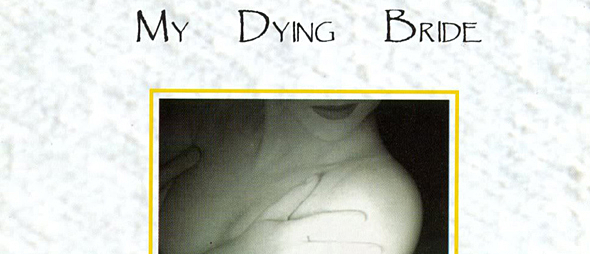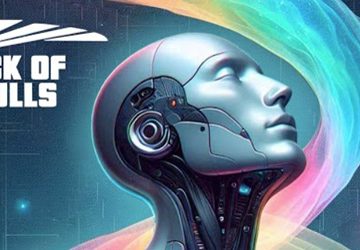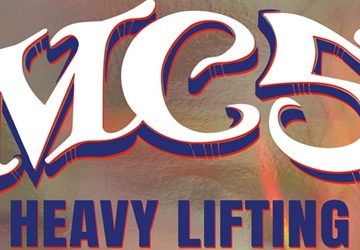My Dying Bride coalesced in 1990 in Bradford, England when former members of Abiosis, namely guitarist Andrew Craighan and drummer Rick Miah, teamed up with a young vocalist by the name of Aaron Stainthorpe and his friend, guitarist Calvin Robertshaw. Along with Anathema and Paradise Lost, My Dying Bride and company single handedly launched the Death Doom variation of Heavy Metal music as we know it today. Referred to as the Peaceville Three, the lads were so named for the record label which had signed them all. Though each band’s career went off in its own unique direction, at the time, the one common thread between them was crushing, oppressive Doom Metal. For My Dying Bride, that meant a penchant for long, miserably wretched odes to sadness and woe, as well as to existential contemplation and religious crisis.
In 1995, after two full-lengths plus a host of EPs and compilation appearances, My Dying Bride had garnered a significant amount of attention in the U.K. and beyond. Firmly on the Peaceville roster, a lineup that included one Martin Powell (ex-Cradle of Filth) on keys and violin got set to release its all important third album. That was twenty years ago, when tape-trading and underground zines were still king. Heavy Metal has continued to morph, curling back on itself to revive styles and trends that died in the throes of their own successes. With no chance to download, rip, burn, or otherwise hijack albums in their infancy, it is a safe bet that the world in ’95 was not at all prepared for what My Dying Bride were about to unleash.
The stark white cover of The Angel and the Dark River jumps out at the observer, with band name and album title typed simply and legibly across its face. The woman framed in the center, all but the severe outline of her lips washed in pale alabaster skin, arms across her breasts, with a bright light glowing upon her shoulder. It engenders to this day a feeling of heartbreak, of lust wrapped in disappointment and mystery. Is the woman closed off from us, or is she merely teasing us?
My Dying Bride’s third album begins with an opus just a shade over twelve minutes in length called “The Cry Of Mankind.” A ballsy move for a band that was still carving its reputation, but that was already their style. Any who look back across twenty years will see the masterpiece it became. Built upon that eerie, unforgettable repetition of riffs, when the wash of feedback cuts the guitars out for that moment and the riff hangs alone in the dense air – it is truly an instance of absolute perfection. The song as a whole is a monolith of crushing despair, buoyant as a freight train being driven straight down onto some unfortunate bastard’s skull. Yet a glorious piano melody arcs through the song like light across the black expanse of a deep lake. Stainthorpe comes over in a listless croon that could rip a heart to pieces with its sadness, the lyrics perhaps the finest attempt to encapsulate the emptiness of god in man’s final despair. This is a theme that pops up frequently in Stainthorpe’s lyrics. God as a fearsome father, offering nothing but contempt and confusing anger to his children. The opening riff, our grim companion throughout the song, fades into the void. Nameless sounds, like the foghorn of some lost ship of the dead, rip and pulse like the universe tearing itself apart as God appears. One could make a fine argument that “The Cry of Mankind” could be the most terrifying song Doom Metal has seen or ever will see. The years have not diminished its power one bit.
“Take your own . . . sick with fever . . .” So begins “From Darkest Skies,” that signature violin and Stainthorpe’s poetry building into a gorgeous tune that works itself up to a pretty heavy, if ponderous chug. The keys, with their seventies vibe, may make this song a distinct influence for some of the retro Metal that is so huge today. Here lies heartbreak, love unrequited, drowning in self-pity, and strangled by one’s own inaction; cheerful this is not. “A Black Voyage” continues the beautiful violins and crushing, tear-soaked riffs. A moving ode to dying in the face of a love doomed to be taken, it keeps the quality sky-high if the spirits interred casket-low.
My Dying Bride came into their own on this album, and nowhere was this more evident than the beginning-a-song-with-a-repeated-phrasing department. For “A Sea To Suffer In,” they bestowed an introductory piano phrasing that is so utterly synonymous with their own brand of Doom. In 1995, it was defining them. Here in 2015, it still stands iron strong. First the guitars follow it, then at about the :35 second mark, Powell comes in on violin and follows the piano’s lilt. Spellbinding, it is truly a My Dying Bride classic. Stainthorpe calls out and is answered by the violin until the breakdown at 2:38. It is a sequence of killer riffing then, until a confident, angry Stainthorpe sounds truly triumphant for the first time on the whole record. The violin following Stainthorpe’s vocal lines does its own little solo/breakdown at around the 5:25 mark, perhaps one of the first times in history a violin rode atop rapid-picking, distorted guitars like that.
Still not drowning in a pool of nihilistic despair? Worry not, dear listener, My Dying Bride is not done with you yet. “Two Winters Only” begins with a lyric asking, “What is it you hope for, even though you are dying?” Not exactly a good brochure slogan for a nursing home, it nonetheless heralds nine minutes of vintage My Dying Bride gloom. Again, the lyrics seem to blame God for his inscrutable ways, his lack of answers in the face of insurmountable human tragedy. Lilting acoustic guitars are the vessel in which this depressing litany is encased. Then four minutes in, a stiff drum fill heralds the return to distortion and that aching violin. The song fluctuates between these two styles, a monument twenty years later to truly heart-wrenching song craft.
“Your Shameful Heaven” takes things in a new direction, playing on repressed sexual urges for bondage and pain, exploding out of control and the shame that goes with that sort of thing. Despite the central role of the violins, the song is catchy and much nearer to straight ahead rocker than any song on the album. The chugging guitars in the bridge with the tight leads over top them sound as vicious today as they did two decades past. The album ends with the inclusion of a song from 1993’s Turn Loose The Swans called “The Sexuality of Bereavement.” Death Metal vocals, slow doom-driven melodies, and that oppressive atmosphere persist once again.
The Angel and the Dark River moved mountains for My Dying Bride, and it could be considered a transition album, as the band shed the Death Metal from their early days for the Goth influenced shores they would soon be treading. Twenty years after its release, it still demands its place at the top of the Doom Metal heap. If one has not heard it yet, but feels an affinity for new school bands like Pallbearer, immediately dive into this stunning third album by My Dying Bride; two decades old this fading Autumn. In the world of Doom, it has seen no rival.







The Angel and the Dark River is my favourite album, not just from My Dying Bride but in general. I love it from the first time I heared it.
Great post! 🙂
hands down, the best MDB album. and i still get goosebumps listening to the cry of mankind, even now, 25 yrs later